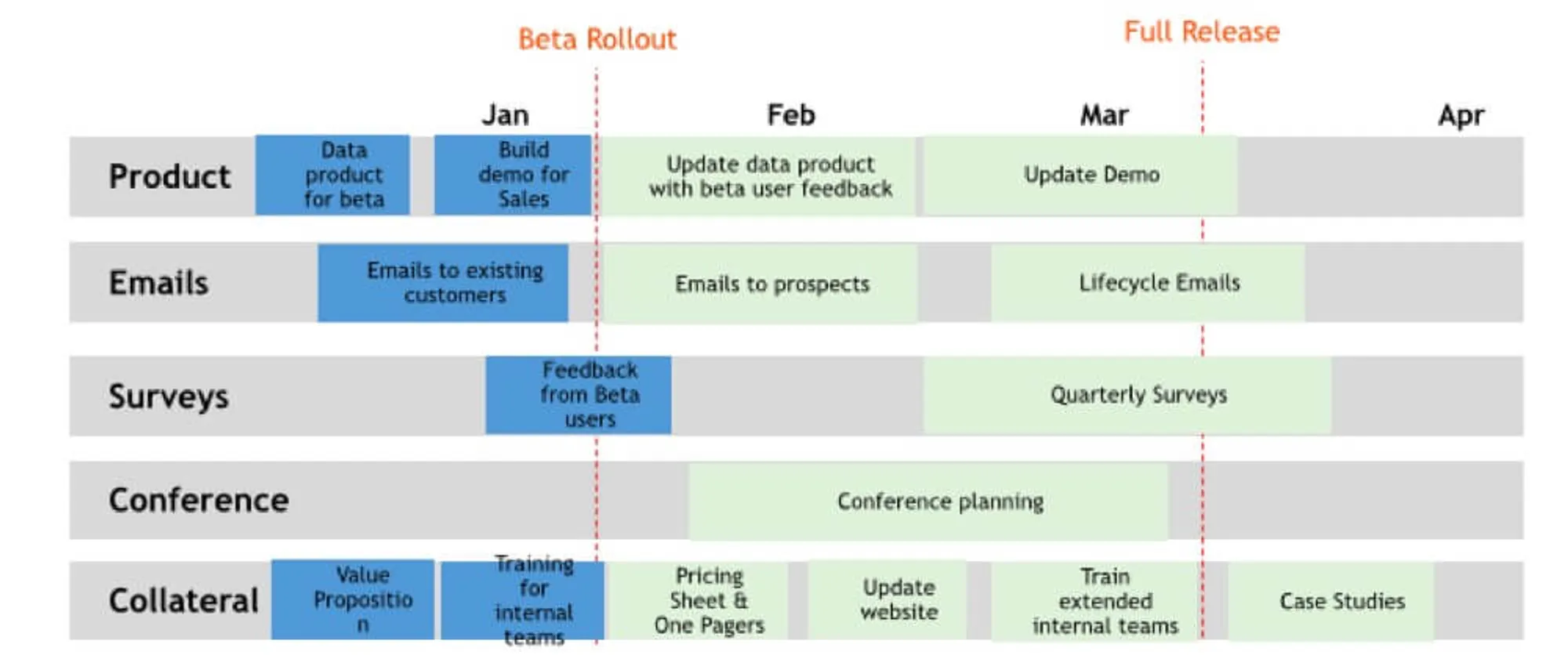How to Develop and Implement a Successful Data Product Launch Plan
Written by GoodData Author |

Table of Contents
What happens after you’ve built your data product? Well, you hope to get it into the hands of your customers. But if the first time you’re thinking about the launch plan for your product is after it is already built, then it is already too late.
Your go-to-market (GTM) and launch planning needs to be started alongside your product development, so that you can execute on it when you have your product ready for pilot, Beta or general availability.
While there are a lot of parts to a GTM and launch plan, the key aspects are listed below, and we’ve aligned them in stages to fit in with when your product is built and ready for launch.
Pre-Launch
- Define value proposition and create a positioning statement for your data product. In this statement, explain the target market and the benefit to your customers; for example, “‘Our Analytics Product’ empowers pharmaceutical manufacturers to analyze transactions and change their processes to improve margins.” Creating this positioning statement allows everyone else in your organization who hasn’t been a part of the product development effort to understand the product and its value and build other key messaging in marketing initiatives.
- Define the metrics for your launch and assign goals so you can track if your launch is successful. Your metrics can be around reach of your launch, adoption of your product, additional revenue you hope to gain with the launch or customer satisfaction if the goal of your data product is to improve your customer’s experience.
- Collaborate with your marketing teams to build collateral for your prospects. Use your positioning statement to drive the material. This could be one-pagers to highlight the core value your customers will get from using the data product, demos built for your target audience or case studies to highlight how other customers have already leveraged your data product.
- Enable and train your sales teams so they are familiar with the data product you’ve built, and can communicate with prospects about how and why it would be valuable to them along with your core product or service. It is especially useful to have a demo version built out for your sales team can leverage.
- If your organization relies on implementation or support teams, this is the time to educate them on your data product and train them on what you’ve built, the value of it and how you expect customers to get up and running with it. Also, define the support process during this stage. Who is responsible for first response? When would you escalate to GoodData support? If you have this process outlined before launching, it definitely saves you from having to put out fires later on!
Why not try our 30-day free trial?
Fully managed, API-first analytics platform. Get instant access — no installation or credit card required.
Get startedLaunch
While your value proposition and positioning will help you understand who your target audience is and the channels you’ll be using to target them, you will still need to pick a launch date and prepare for activities leading up to and during your launch period so that you can engage these target customers. The strategy you pick for your beta product can be different from the one you employ for general launch. Depending on your marketing strategy, you may decide to include the following activities in your launch:
- Webinars for prospects or webinars along with customers already using your data product
- Blog posts and articles
- Targeted email campaigns with curated content or offers to trial the data product for a period of time
- Live event - our customers have pitched their data products at different industry conferences or customer workshops
We also recommend creating a launch plan and keeping these dates in mind as you work on building your data product. Here are some examples of a high-level and detailed plan:


Post Launch
After your initial launch is complete, continue activities post launch as well to keep the interest high amongst your prospects and customers. Also, if you did a beta launch and are going to plan for the full product launch later on, this is a good time to analyze the results of your beta launch and use them to influence your strategy.
- Continue your marketing efforts by including content on your data product in your organization’s content strategy and cadence. Refresh case studies and customer webinars frequently.
- Track progress against your metrics and refine your launch strategy. Are you reaching the customers you had wanted to? Are you hitting the adoption and revenue goals you had planned for? If not, think about how to refine your launch strategy for the next release or how you can continue to reach your target with ongoing activities.
- Finally, collect and analyze customer feedback post launch so you can use it to influence your product roadmap. Its also important to set up a mechanism to collect this feedback frequently. Will you be gathering feedback via surveys, customer focus groups, online community or from your support team? If your organization relies on an implementation team to set up your product and the data product for your customers, then create a process to gain feedback from this team as well.
Why not try our 30-day free trial?
Fully managed, API-first analytics platform. Get instant access — no installation or credit card required.
Get startedWritten by GoodData Author |

